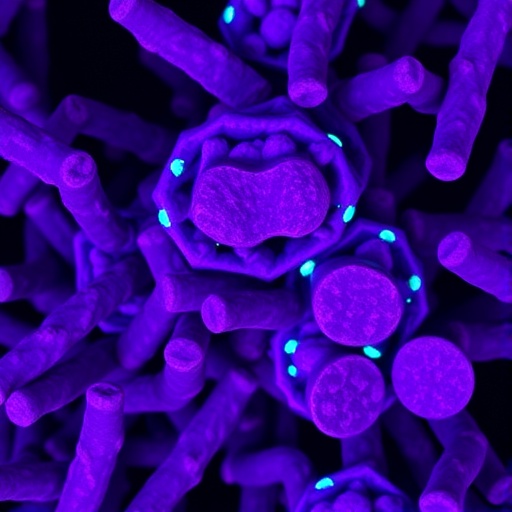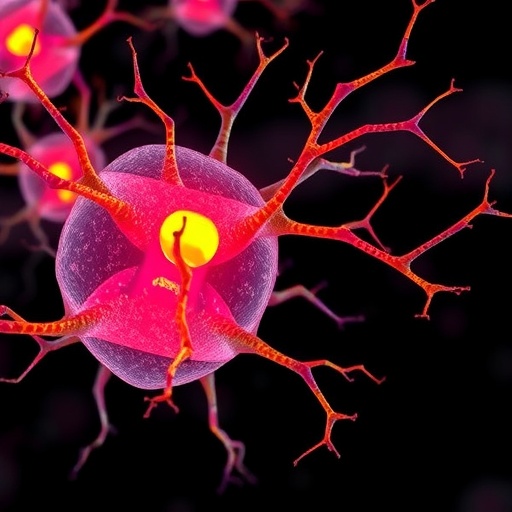In a groundbreaking study published in the Journal of Translational Medicine, researchers have unveiled critical insights into the biomechanical properties of the pancreatic ductal adenocarcinoma (PDAC) stroma and how these elements mediate tumor behavior. Understanding the intricate relationship between cancer progression and the surrounding tissue environment is pivotal in developing targeted therapies. This detailed exploration by Yang et al. marks a significant step in harnessing the biomechanical properties of tumor-associated stroma as a potential therapeutic avenue in cancer treatment.
The investigation primarily focuses on ITGB5, a protein that has emerged as a crucial player in modulating the mechanical properties of the tumor microenvironment. ITGB5 is an integrin that facilitates cell attachment and communication with the extracellular matrix (ECM). The role of integrins in cancer has been extensively documented; however, the specific implications of ITGB5 in pancreatic cancer’s stroma represents a new frontier in cancer biology. It acts not just as a structural component but as an influencer of cellular behavior, influencing cellular adhesion, migration, and proliferation within the pancreatic stroma.
Through comprehensive studies, the authors demonstrated that the expression of ITGB5 is significantly heightened in PDAC compared to normal pancreatic tissue. This upregulation suggests that ITGB5 might contribute to an altered biomechanical landscape in the tumor microenvironment, potentially leading to aggressive tumor phenotypes. The research findings indicate a correlation between high ITGB5 levels and poor prognostic outcomes, suggesting that monitoring ITGB5 expression could serve as an important biomarker for cancer progression.
Employing advanced imaging techniques alongside biomechanical assays, Yang and colleagues meticulously characterized the mechanical properties of the stroma. They observed that PDAC stroma exhibited increased stiffness compared to healthy tissue. This increased stiffness can promote invasive tumor characteristics, as it influences the migration of tumor cells. Additionally, the study highlighted the importance of the stroma in providing not just structural support but also biochemical cues that drive tumorigenesis and metastasis.
The researchers conducted a series of in vitro and in vivo experiments to elucidate the role of ITGB5 in overgrown pancreatic tumors. By silencing ITGB5 in cell lines derived from PDAC, they demonstrated a marked reduction in the migratory capabilities of these cells, reinforcing the notion that ITGB5 facilitates tumor cell spread. Furthermore, preclinical models that had reduced levels of ITGB5 showed diminished tumor growth and metastasis, providing compelling evidence for the protein’s pivotal role in tumor progression.
Beyond the basic science implications, these findings present potential translational applications. Targeting ITGB5 may offer a promising strategy to interrupt the mechanical and biochemical signaling pathways critical for tumor development and progression. With the rise of personalized medicine, pharmacological inhibitors of ITGB5 or agents that modulate the biomechanical properties of the stroma could change the treatment landscape for patients diagnosed with pancreatic cancer.
The malignant nature of PDAC is underscored by its notorious resistance to conventional therapies, thus presenting a significant challenge for clinicians. As the study suggests, focusing on the stromal microenvironment may yield new therapeutic strategies that could sensitize tumors to existing treatments or improve overall patient outcomes. This underscores the necessity for oncologists to pivot towards a more integrated approach that considers both tumor cells and their supporting stroma.
The implications of this study extend to patient management as well. Clinicians may begin to utilize ITGB5 levels as part of their prognostic assessments for pancreatic cancer patients. Elevated levels could signal the need for more aggressive treatment approaches, facilitating tailored therapies designed to target the unique biomechanical characteristics of individual tumors.
In addition to promoting cancer progression, the study also highlights the protective role that the stroma can play. While an altered biomechanical environment can aid tumor growth, it may also exhibit a barrier effect, preventing efficient chemotherapy delivery. Therefore, this research lays the groundwork for further studies aimed at not only understanding but manipulating these biomechanical interactions for clinical benefit.
While this study opens new avenues in cancer research, it also poses questions for future investigation. How do the findings around ITGB5 interplay with other signaling pathways involved in PDAC? What are the potential side effects of targeting such pathways? These questions are essential to consider as researchers embark on the next phases of clinical application.
As scientists dissect the complex interactions within the tumor microenvironment further, we can anticipate a shift in focus that integrates biomechanical properties with traditional oncological treatment paradigms. Ultimately, this research paves the way for breakthroughs in personalized treatment for one of the most aggressive forms of cancer, offering hope for patients and their families.
With ongoing investigations and growing interest in the tumor microenvironment’s role, the future promises more innovative strategies and potentially life-saving therapies. The work of Yang et al. exemplifies how a deeper understanding of molecular and mechanical dynamics in the stroma could translate into tangible benefits for pancreatic cancer patients in the near future. Advancements in this field mark a hopeful progression towards improved diagnostics, prognostics, and treatment strategies to combat the formidable challenge of pancreatic ductal adenocarcinoma.
Understanding the detailed interactions between stroma and tumor cells is likely to revolutionize our approach to treatment, making it a very exciting time for cancer research. The continued exploration of how structural elements influence tumor biology can inspire new therapeutic strategies complemented by emerging technologies in medicine. As research unveils the complexity of these interactions, we stand on the precipice of transforming cancer treatment and significantly improving patient survival rates.
In summary, the work led by Yang et al. underscores a crucial element in the oncology landscape: the biomechanical properties of the tumor microenvironment. As we move forward, it is essential to harness this knowledge, bridging the gap between laboratory research and clinical practice to enhance treatment modalities and outcomes for patients grappling with the challenges posed by pancreatic ductal adenocarcinoma. The importance of multidisciplinary approaches, where engineering, biology, and medicine converge, cannot be overstated in this rapidly evolving field.
Subject of Research: ITGB5-mediated biomechanical regulation in pancreatic ductal adenocarcinoma stroma and its impact on tumor progression and prognosis.
Article Title: ITGB5-mediated biomechanical regulation in pancreatic ductal adenocarcinoma stroma impacts tumor progression and prognosis.
Article References:
Yang, A., Gu, C., Liu, Y. et al. ITGB5-mediated biomechanical regulation in pancreatic ductal adenocarcinoma stroma impacts tumor progression and prognosis.
J Transl Med 23, 1150 (2025). https://doi.org/10.1186/s12967-025-07119-5
Image Credits: AI Generated
DOI: 10.1186/s12967-025-07119-5
Keywords: ITGB5, pancreatic ductal adenocarcinoma, tumor microenvironment, stroma, cancer progression, biomechanical properties.
Tags: biomechanical properties of tumorscancer treatment advancementscellular behavior in tumor stromaextracellular matrix and cancerinsights into cancer stroma interactionsintegrins in cancer biologyITGB5 in pancreatic cancerpancreatic ductal adenocarcinoma stromarole of ITGB5 in tumor biologytargeted therapies for pancreatic cancertumor microenvironment and cancer progressionupregulation of ITGB5 in PDAC





